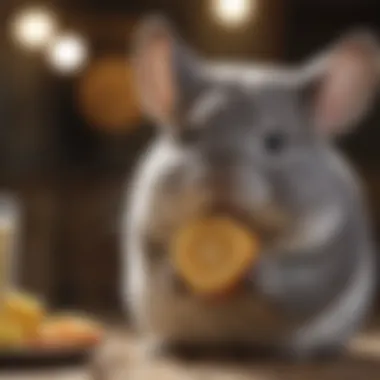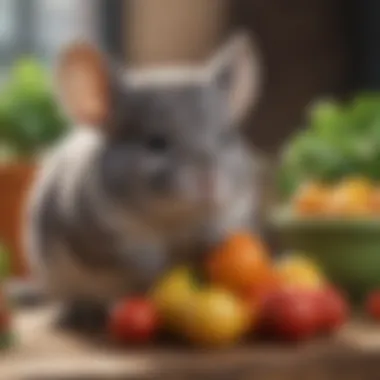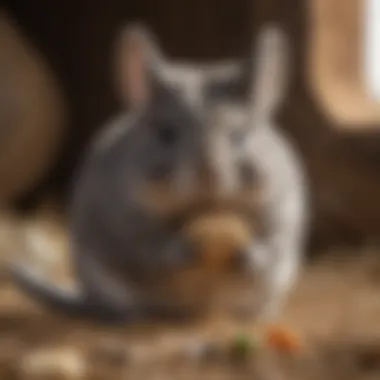Safe Treats for Chinchillas: A Comprehensive Guide


Intro
Understanding Your Pet
Pet Behavior Basics
Chinchillas are naturally curious creatures. They display playful behaviors, which can be delightful to observe. Understanding their typical behavior helps in choosing suitable treats. For example, chinchillas often love to chew, making treats that promote dental health ideal. Observing their reactions to different treats can provide insight into their preferences and satisfaction levels.
Common Breed Characteristics
Most pet chinchillas belong to the Chinchilla lanigera species. They have dense fur and large eyes. Their ability to jump and climb is notable. Each chinchilla may have unique traits based on their breed or individual personality. Knowing these characteristics helps in selecting treats that align with their behavior and activity level.
Species-Specific Needs
Chinchillas require a high-fiber diet with limited sugar and fats. Their primary food source should be high-quality hay, such as timothy or orchard hay. Treats should complement this basic diet. When selecting snacks, be mindful that chinchillas thrive on natural ingredients over processed options.
Choosing Safe Treats
Recommended Treats
When considering treats for your chinchilla, some options are particularly beneficial.
- Dried herbs: Examples include dandelion leaf and chamomile, which can aid digestion.
- Timothy hay cubes: These encourage chewing and help maintain dental health.
- Small pieces of fruits: Apple or pear can be given sparingly.
- Dried flowers: Such as hibiscus, can be a delightful addition.
What to Avoid
Not all treats are safe. Some common snacks can pose risks:
- Seed and nut mixes: High in fat, which can lead to obesity.
- Human snacks: Foods like chocolate, chips, and other processed items are harmful.
- Certain fruits: Grapes, raisins, or citrus can upset their digestive systems.
Always research and verify the safety of any treat before offering it to your chinchilla.
Introducing New Treats
Gradual Prologue
When introducing new treats, patience is key. Start with a small amount to see how your chinchilla reacts. Monitor for any adverse effects, such as changes in behavior or digestive issues. Keep a log of which treats were introduced and your pet's responses.
Portion Control
Treats should be given in moderation. Too many can disrupt their digestive health. A rule of thumb is that treats should not exceed 10% of their total diet. This ensures that the majority of their nutrition comes from hay and pellets.
Observing Reactions
Paying close attention to how your chinchilla responds to treats is essential. If they show signs of discomfort or distress, it may be wise to discontinue that particular treat. Ensuring their comfort and health should always be your top priority.
Culmination
Treats can enhance the bond between you and your chinchilla while offering them enjoyment. Understanding their needs and monitoring what they eat is the first step toward making informed choices. Always prioritize their health by selecting safe options and introducing them thoughtfully. With careful considerations, treats can be a delightful part of your chinchilla's life.
Understanding Chinchilla Nutrition
Understanding the nutrition of chinchillas is fundamental for providing them with optimal care and fostering their well-being. As unique creatures, chinchillas have specific dietary requirements that differ significantly from those of other pets. Their digestive systems are finely tuned to process fibrous materials. This section will explore the essential elements of chinchilla nutrition, outline the significance of proper dietary choices, and discuss considerations necessary for maintaining their health.
Digestive System Overview
Chinchillas possess a complex digestive system suited primarily for processing high-fiber diets. They are herbivores, and their intestines are designed to extract nutrients from tough plant materials. The structure of their digestive tract includes a large cecum, which plays a crucial role in fermentation. This process allows chinchillas to break down fibrous foods effectively. Additionally, their teeth continually grow, requiring constant wear through chewing on hay and other fiber-rich treats.


Ensuring that chinchillas have a diet rich in high-quality hay is essential. Hay such as timothy or orchard grass serves as a primary food source, providing necessary fibers for their digestive health. Dry and coarse materials prevent overgrowth of teeth and maintain gut motility. A better understanding of their digestive needs will help pet owners choose suitable treats, avoiding options that may disrupt this delicate system.
Basic Dietary Requirements
An ideal diet for chinchillas revolves around a balance of hay, pellets, and limited treats. Key aspects of their basic dietary requirements include:
- Hay: This should make up the bulk of their diet. It promotes dental health and digestive efficiency.
- Pellets: High-quality commercial pellets formulated specifically for chinchillas are vital. Avoid those with added sugars or artificial flavors.
- Fresh Water: Always provide clean and fresh water. Dehydration can lead to severe health issues.
In addition, a few safe treats can enhance their diet. However, moderation is crucial. Introducing new treats slowly and watching for any adverse reactions is important.
Understanding the nuances of chinchilla nutrition enables owners to make informed decisions about their feeding practices. Educating oneself about these dietary requirements can lead to healthier, happier chinchillas.
Role of Treats in a Chinchilla's Diet
The inclusion of treats in a chinchilla's diet serves multiple purposes. While the foundation of a chinchilla’s diet is hay, pellets, and water, specially chosen treats can enhance their overall well-being. Treats provide a way to incorporate variety into a typically monotonous diet. This is especially important for captive animals like chinchillas, whose diets can often lack the diversity found in their natural habitats.
Nutritional Benefits of Treats
Treats can provide valuable nutrients that might not be sufficiently present in standard chinchilla food. For instance, naturally dried fruits such as apple slices and papaya can offer essential vitamins and antioxidants. Incorporating these into the diet can boost the immune system and enhance skin and coat health. However, moderation is key; excessive sugar content in some fruits can lead to digestive issues, making it important to select only safe options.
Furthermore, herbal treats like chamomile flowers and dandelion greens bring more than just taste to the diet. They can aid digestion, promote relaxation, and even improve dental health due to their natural textures. Keeping a balance of nutrients ensures that treats serve a beneficial role rather than just being empty calories.
Psychological Enrichment and Bonding
Beyond physical health, treats play a significant role in the psychological well-being of chinchillas. Receiving a treat can be a rewarding experience, fostering a stronger bond between the pet and the owner. When a chinchilla learns to associate treats with positive experiences, it can lead to a more affectionate and trusting relationship. This emotional aspect is vital not only for the owner-pet dynamic but also for the overall mental state of the chinchilla.
It is also critical to note that offering treats can encourage natural behaviors, such as foraging. By hiding treats in their enclosure or using them during playtime, owners can stimulate their pet’s curiosity and physical activity. Such engagements help to prevent boredom, which can lead to undesired behaviors in chinchillas.
When considering treats for chinchillas, it is essential to choose options that are not only enjoyable but also nutritious. The types of treats available can vary greatly, and understanding their benefits and potential drawbacks helps ensure the wellbeing of these sensitive animals. Ideal options contain wholesome ingredients that safeguard their unique digestive systems while providing mental stimulation. Here we will examine three main categories of safe treats: natural dried fruits, herbal treats, and specialty chinchilla treats. Each type serves a distinctive role in enriching a chinchilla's diet while preserving its health.
Natural Dried Fruits
Natural dried fruits offer an excellent choice when selecting treats for chinchillas. These treats, when prepared without added sugars or preservatives, can provide essential nutrients and antioxidants. However, moderation is crucial, as the natural sugars in fruits can accumulate and lead to health issues if given excessively.
Dried apple slices
Dried apple slices are a popular selection among chinchilla owners. The key characteristic of these slices is their crunchy texture, which appeals to chinchillas’ natural instinct to chew. Dried apple slices are low in calories and contain dietary fiber, which aids in digestion. Additionally, they are rich in vitamins, particularly vitamin C. This makes them a beneficial choice for maintaining the overall health of chinchillas. One unique feature is that they mimic foraging behavior, encouraging exercise and mental engagement. However, it’s vital to introduce them gradually to prevent any digestive issues.
Dried papaya
Dried papaya is another excellent option for chinchillas. The main appeal of dried papaya lies in its unique enzyme content, specifically papain, which can aid in digestion. This tropical fruit is not only tasty but also packed with vitamins such as A, C, and E, contributing positively to a chinchilla's immune system. Its chewy texture and vibrant color can stimulate a chinchilla's interest, making it a popular choice among pet owners. Nevertheless, some chinchillas may find it overly sweet, so care must be taken to monitor individual responses and adjust offerings accordingly.
Herbal Treats
Herbal treatments add diversity to a chinchilla's diet while providing additional health benefits. They can be a source of vitamins, minerals, and other compounds that support overall wellbeing. Incorporating herbal options encourages natural foraging behaviors, which is very important for chinchillas in captivity.
Chamomile flowers
Chamomile flowers can be a soothing treat for chinchillas. The calming properties of chamomile are beneficial for stress relief. In addition, they contain antioxidants that may eliminate damaging free radicals from the body. Their aroma can also provide comfort to chinchillas, making their environment feel more enriched. However, it is important to use chamomile in moderation due to its diuretic properties, which could lead to dehydration if given excessively.
Dandelion greens
Dandelion greens are an excellent choice and are known for their high nutritional value. They are rich in vitamins A, C, and K, along with essential minerals such as iron and calcium. The bitter taste often appeals to chinchillas, which encourages natural feeding habits. Dandelion greens can vary in availability, often found in gardens or purchased at pet stores. Nonetheless, care must be taken to avoid over-foraging in contaminated areas, as chemicals can harm chinchillas. Properly sourced, these greens are a fantastic addition to any treat regimen.
Specialty Chinchilla Treats
Specialty chinchilla treats are designed to meet the unique dietary needs of these animals. These products can offer specific nutritional profiles and often include additional benefits tailored to improve health and wellbeing.
Commercially prepared treats


Commercially prepared chinchilla treats are widely available and often formulated to provide balanced nutrition. These treats come in various forms, such as pellets or biscuits. Many contain a mix of fibers, vitamins, and minerals, making them a practical choice for busy pet owners. However, careful scrutiny of ingredient lists is crucial, as some products may include fillers or artificial flavors that can harm a chinchilla’s health. Selecting high-quality brands minimizes these risks and ensures optimal benefits for your pet.
Fortified snacks
Fortified snacks differ from regular treats in that they usually have enhanced nutritional content. These snacks are developed to include additional vitamins and minerals that chinchillas may require. This is particularly beneficial for those chinchillas with specific health concerns or dietary restrictions. While these snacks can provide significant advantages, they should still be offered sparingly. Overindulgence might disrupt the balance of their diet, leading to health complications.
Potential Risks of Common Snacks
Understanding the potential risks of certain snacks is essential for maintaining the health of chinchillas. Many foods that are safe and nutritious for humans can be harmful or even toxic to chinchillas. Recognizing these risks helps pet owners make informed decisions and avoid common pitfalls.
Human Foods to Avoid
Chocolate
Chocolate is widely known for its appeal to humans, often regarded as a delightful treat. However, for chinchillas, chocolate is dangerous. It contains theobromine, a compound that chinchillas cannot metabolize effectively. Even small amounts can lead to serious health issues, such as heart problems or even death. This highlights the necessity of avoiding chocolate completely in their diet.
- Key Characteristic: Theobromine toxicity.
- Why It’s a Hazard: It can cause severe health issues for chinchillas.
- Conclusion: Inclusion of chocolate in a chinchilla's diet is not just a poor choice, but a detrimental one.
Citrus Fruits
Citrus fruits are often praised for their vitamin C content, which is significant for many animals, including humans. However, chinchillas have a different dietary requirement. Citrus fruits can lead to digestive upset due to their high acidity, which chinchillas' digestive systems are not designed to handle. When introducing new foods, it is critical to remember that not everyone benefits the same way.
- Key Characteristic: High acidity and sugar content.
- Why It’s a Hazard: It can lead to gastrointestinal issues, thus harming the chinchilla's overall health.
- Conclusion: Citrus fruits should be strictly avoided to protect the well-being of chinchillas.
Nuts
Nuts are often seen as nutritious snacks for humans, rich in healthy fats and proteins. In contrast, they carry a risk for chinchillas. Their high-fat content can lead to obesity, which is a significant concern. Chinchillas are delicate animals, and too many fats can disrupt their digestive systems and overall health. Therefore, while nuts seem appealing, they are not suitable treats for these small mammals.
- Key Characteristic: Rich in fats.
- Why It’s a Hazard: Risk of obesity and digestive problems.
- Conclusion: Nuts should be excluded from a chinchilla's diet to ensure their health remains stable.
Consequences of Unsafe Treats
The consequences of feeding chinchillas unsuitable treats can be severe. These may include:
- Digestive issues: Vomiting and diarrhea can result from inappropriate foods.
- Nutritional deficiencies: Some treats lack essential nutrients, harming the chinchilla’s growth and immunity.
- Organ damage: Long-term consumption of harmful foods may lead to serious organ damage or failure.
In summary, understanding the potential risks of common snacks is crucial for every chinchilla owner. By avoiding certain foods, owners can help ensure their pets remain healthy, happy, and thriving.
How to Introduce New Treats
Introducing new treats to a chinchilla’s diet is a crucial process that can significantly impact their health and happiness. Understanding how to incorporate treats effectively will help prevent digestive distress and encourage positive eating behaviors. Chinchillas have sensitive digestive systems, and sudden changes in their diet can lead to serious health issues. Therefore, a gradual and monitored approach is essential when introducing new foods, including treats. This ensures that your chinchilla adapts well to the new items, and you can keep track of any potential reactions, whether positive or negative.
Gradual Prelims Process
When introducing new treats to your chinchilla, it is important to take a gradual approach. Start by offering a very small amount of the new treat alongside their usual food. This can be a sliver of dried fruit or a few dried herbs. Wait for a few days to observe how your chinchilla reacts to the treat. If they seem to enjoy it without any adverse reactions, you can slowly increase the quantity over time.
Here are some steps to follow:
- Choose a Safe Treat: Ensure the treat is safe by researching specific options that are generally considered safe for chinchillas.
- Offer a Small Amount: Provide a tiny portion alongside their regular diet. A small piece goes a long way in the beginning.
- Observe Their Response: Watch for any signs of digestive issues such as diarrhea, lethargy, or discomfort.
- Increase Portion Gradually: If there are no problems, you can increase the serving size gradually.
Using this method helps your chinchilla adjust to the flavor and texture of the new treat without overwhelming their digestive system.
Monitoring Your Chinchilla's Response
It is essential to monitor your chinchilla's response to new treats closely. Each chinchilla has unique preferences and tolerances, which means what works for one may not suit another. Look for specific behavioral and physical responses. This should include observing their eating habits, energy levels, and their overall demeanor.
Key aspects to pay attention to:
- Eating Behavior: Is your chinchilla excited to eat the new treat, or does it ignore it?
- Physical Health: Monitor for any signs of digestive discomfort, such as changes in stool consistency.
- Activity Level: A decrease in energy may indicate that the treat does not agree with them.


A gradual introduction and careful monitoring can minimize risks and ensure a smooth transition to new treats, promoting a happier and healthier chinchilla.
Recording your observations can help track trends and reactions over time. If you notice any alarming signs, avoid giving that particular treat again, and consult with a veterinarian if necessary. This cautious and attentive approach can help enhance your chinchilla's quality of life.
Moderation and Treat-Specific Guidelines
Understanding the need for moderation in your chinchilla's diet is critical for the pet's health. Chinchillas have a delicate digestive system. Overindulgence in treats can lead to obesity or digestive issues. Therefore, pet owners must carefully consider the frequency and size of treats offered.
Setting Treat Limits
Frequency of treats
The frequency of treats is essential for maintaining healthy eating habits. Offering treats too often can confuse your chinchilla's appetite. This may lead to a preference for treats over essential foods. Treats should be given sparingly—perhaps two to three times a week. This limitation encourages chinchillas to continue eating their main diet of hay, pellets, and fresh greens , which supports their overall well-being.
A key characteristic of this approach is that it helps with weight management. Regularly monitoring your chinchilla’s weight can ensure they do not become overweight. Furthermore, too frequent treats might reduce the excitement of receiving them, as they could become mundane.
Portion sizes
Along with frequency, portion sizes play a vital role in treat moderation. A small piece of dried fruit or a few herbal treats can go a long way. Understanding and controlling portion sizes help in preventing overconsumption. Ideally, a treat should not exceed 10% of their daily food intake.
One unique feature of maintaining proper portion sizes is that it allows for variety. You can introduce different types of treats without risking digestive disturbances. As a downside, if portions are too small, it might seem like an unsatisfying experience for the chinchilla. However, emphasizing quality over quantity leads to a healthier diet overall.
Maintaining a Balanced Diet
Balancing a chinchilla's diet becomes more straightforward with focused treat guidelines. Treats should not overshadow the primary diet, which consists mainly of hay and specially formulated pellets. To maintain a healthy equilibrium, prioritize nutrient-dense foods.
A balanced diet ensures that chinchillas receive necessary vitamins and minerals. This balance not only promotes health but also supports vibrant fur and energy levels. For example, fresh hay should always be readily available, as it makes up the bulk of their diet.
Summary of Key Points
Understanding the significance of treats within the broader context of chinchilla care is essential. This section encapsulates the core insights provided throughout the article. Recognizing how safe treats contribute to a chinchilla's overall health and well-being can help pet owners make informed choices.
Key Considerations with Chinchilla Treats:
- Nutritional Value: Not all treats are created equal. It's crucial to opt for treats that complement the primary diet of hay and pellets. Natural dried fruits and organic herbal options offer nutritional benefits without excessive sugar or harmful additives.
- Moderation is Essential: Treats should never make up a large portion of the chinchilla’s diet. The advice presented emphasizes balancing treats with staple foods in order to prevent dietary imbalances.
- Gradual Introduction: New treats should be introduced slowly. Observing how a chinchilla reacts to different snacks can help identify what is beneficial or harmful, allowing owners to tailor a diet that promotes health.
- Avoiding Risks: Knowledge of potentially harmful foods is vital. Many everyday human foods are detrimental to chinchillas. Being aware of these risks can prevent serious health complications.
- Psychological Engagement: Offering a variety of safe snacks serves not only nutritional needs but also provides enrichment. This can foster bonding between the pet and owner, enhancing the overall pet care experience.
"Understanding these key points can pave the way for a healthier and happier chinchilla."
In summary, being well-informed about the best practices for treating chinchillas is crucial. Following the guidelines discussed will ensure treats are a positive addition to your pet's diet, ultimately contributing to their well-being and happiness.
Essential Takeaways on Chinchilla Treats
The information gathered in this article serves several essential functions for chinchilla owners. Here are the main takeaways to remember:
- Choose Wisely: Prioritize natural and safe treat options over commercially processed ones that may contain harmful ingredients.
- Monitor Responses: Always pay attention to how chinchillas react to treats. If any signs of distress appear, it is best to discontinue that particular treat.
- Educate Yourself: Stay informed about safe and unsafe foods for chinchillas through reliable sources like Wikipedia, Britannica, or pet-focused forums on platforms like Reddit.
- Community Support: Engage in online communities and social circles related to pet care for shared knowledge and support in your journey as a chinchilla owner.
By understanding these takeaways, chinchilla owners can cultivate a nurturing environment that significantly enhances their pets' quality of life.
Further Resources for Chinchilla Owners
Access to reliable resources is crucial for chinchilla owners who seek to provide the best possible care for their pets. Understanding the intricacies of chinchilla nutrition, health, and behavior can significantly enhance the relationship between a pet and its owner. By equipping themselves with knowledge, owners can make informed decisions regarding their chinchilla’s diet and general wellbeing. In this section, we will explore various resources that can offer valuable information on safe treats and overall chinchilla care.
Books and Guides
Books and guides serve as fundamental tools for learning about chinchilla care. They offer detailed insights into various topics, including diet, habitat, and health concerns. Some noteworthy titles include:
- The Complete Guide to Chinchillas by K. Amy
- Chinchillas: A Complete Pet Owner's Manual by Bob H. Peters
- Chinchillas: Care, Behavior, and Compatibility by Mary Ann Mulligan
Online Communities and Forums
Engaging with online communities and forums can further enrich the experience of owning a chinchilla. Platforms such as Reddit and Facebook host groups specifically dedicated to chinchilla enthusiasts. Here, owners can share their experiences, ask questions, and seek advice from fellow pet owners. Some of the benefits of participating in these communities include:
- Real-time assistance: Owners can receive immediate guidance on pressing issues or concerns.
- Shared experiences: Learning from others can prevent common mistakes and enhance care strategies.
- Community resources: Members often share links to articles, videos, and other educational materials relevant to chinchilla care.
For those interested, visit reddit.com to find chinchilla-centric subreddits or search for Facebook groups centered around chinchilla ownership. These platforms can be an excellent avenue for continuous learning and support, complementing more formal resources like books.







